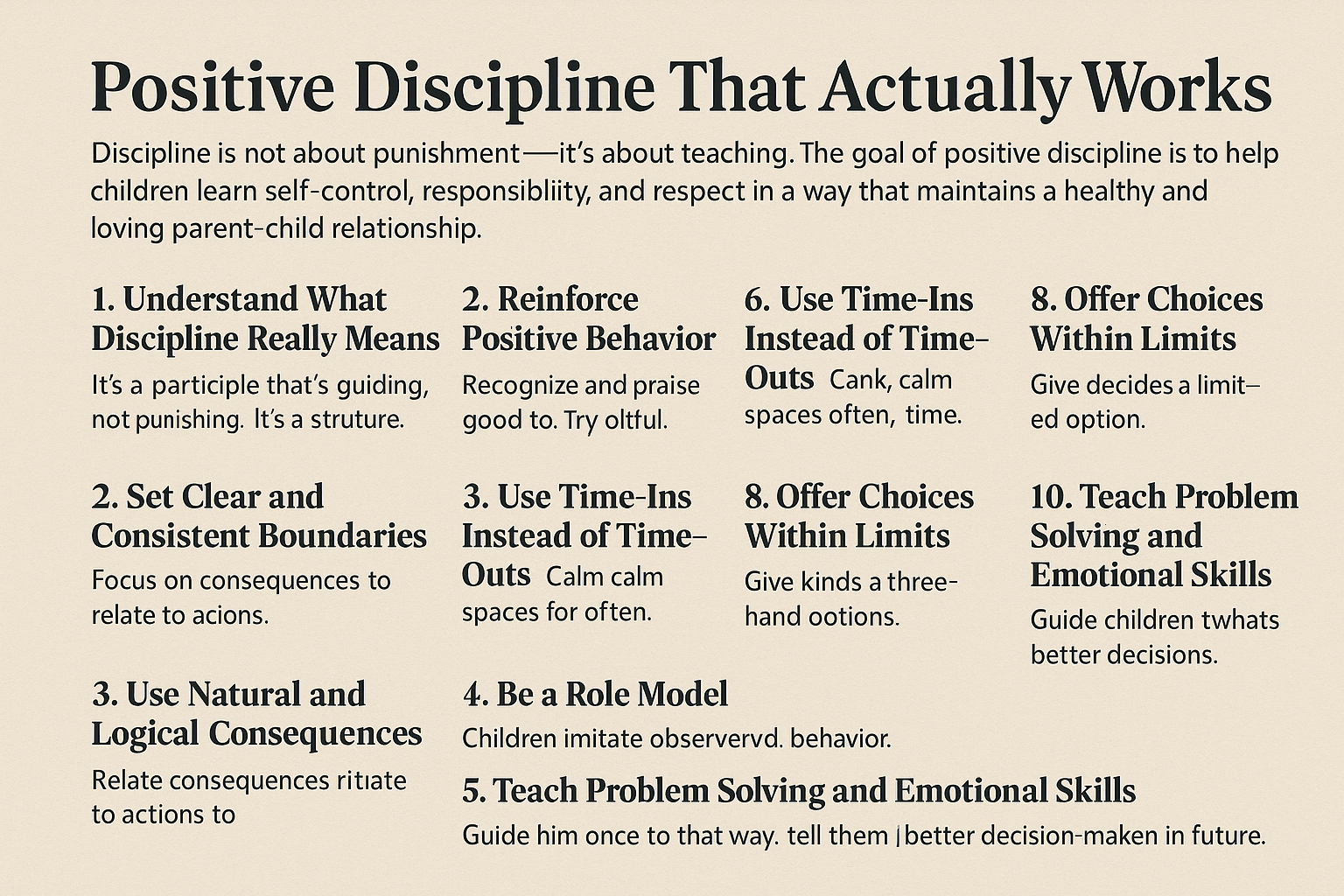Discipline is not about punishment — it’s about teaching. The goal of positive discipline is to help children learn self-control, responsibility, and respect in a way that maintains a healthy and loving parent-child relationship.
Rather than using fear or shame, positive discipline is based on mutual respect, clear boundaries, and consistent guidance. Let’s explore what it means — and how you can apply it in real life.
1. Understand What Discipline Really Means
The word “discipline” comes from the Latin disciplina, meaning “instruction” or “training.” Positive discipline focuses on guiding, not punishing. It’s about helping children:
- Learn from their mistakes
- Understand the consequences of their actions
- Develop problem-solving skills
- Grow into responsible, respectful individuals
It’s not permissiveness — it’s structure delivered with kindness.
2. Set Clear and Consistent Boundaries
Children need to know what’s expected of them. When rules are unclear or constantly changing, they feel confused and insecure.
Be clear and consistent with your expectations. Instead of saying “Be good,” try:
- “Use gentle hands.”
- “We keep our toys in the basket after playtime.”
- “We speak to each other kindly.”
The more specific and consistent your rules, the easier it is for kids to follow them.
3. Use Natural and Logical Consequences
Instead of threats or punishments, focus on consequences that relate directly to the behavior.
Natural consequences happen on their own:
- If a child refuses to wear a coat, they feel cold.
Logical consequences are related and reasonable:
- If they draw on the wall, they help clean it up.
- If they break a toy by throwing it, it doesn’t get replaced.
This teaches cause and effect — not fear.
4. Stay Calm and Respectful
Yelling might stop behavior in the moment, but it damages trust over time. Children learn best when they feel safe and respected.
If you feel overwhelmed, pause. Take a deep breath. Respond instead of reacting. A calm tone and respectful body language make a big difference.
Model the kind of behavior you want to see.
5. Focus on Teaching, Not Controlling
Instead of saying, “Because I said so,” explain your reasons:
- “We don’t run in the street because it’s dangerous.”
- “I’m asking you to clean up so our space stays nice for everyone.”
This helps kids understand the why behind the rule and builds their internal motivation.
6. Reinforce Positive Behavior
Catch your child doing something right. Praise effort, kindness, cooperation, and honesty.
Use specific praise like:
- “I noticed how gently you helped your little brother. That was kind.”
- “Thanks for putting your shoes away without being asked.”
Positive reinforcement strengthens the behaviors you want to see more of.
7. Use Time-Ins Instead of Time-Outs
Instead of sending your child away when they misbehave, invite them to sit with you and calm down.
A time-in is a moment to connect and reset:
- “Let’s sit together and take some deep breaths.”
- “I see you’re having a hard time. I’m here with you.”
This strengthens your relationship and teaches emotional regulation.
8. Offer Choices Within Limits
Give children age-appropriate choices to help them feel empowered:
- “Do you want the red cup or the blue one?”
- “Would you like to do your homework before or after your snack?”
This reduces power struggles and teaches decision-making.
9. Be a Role Model
Children learn more from what you do than what you say. Model honesty, patience, respect, and problem-solving in your daily actions.
If you make a mistake, acknowledge it:
- “I raised my voice, and that wasn’t okay. I’m sorry. Let’s try again.”
Your behavior teaches them how to act during conflict and challenges.
10. Teach Problem Solving and Emotional Skills
When your child acts out, guide them in understanding what happened and how to handle it better next time.
Ask:
- “What were you feeling when that happened?”
- “What can we do differently if it happens again?”
Help them name their feelings and brainstorm solutions. Over time, they’ll internalize these skills.
Final Thought: Positive Discipline Builds Lifelong Skills
Discipline isn’t about forcing obedience — it’s about building character. With consistency, empathy, and clear guidance, you can help your child develop the tools they need to navigate the world with confidence and kindness.
Positive discipline is not always the fastest route — but it’s the one that builds a stronger relationship and sets your child up for long-term success.
